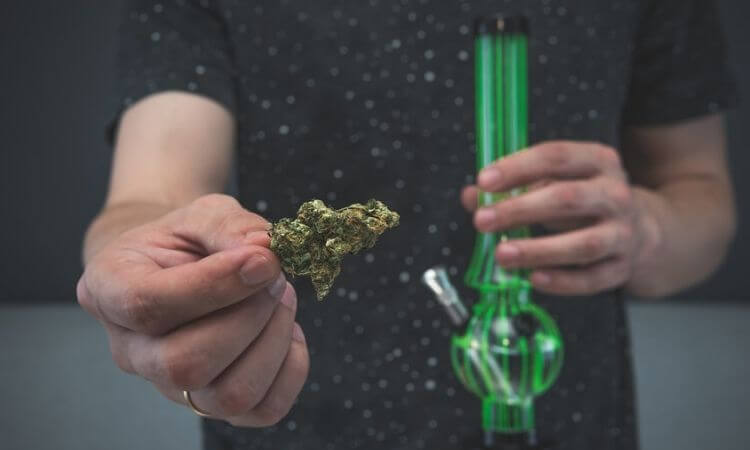
The term “marijuana” is used to refer to the dried leaves, flowers, seeds, and stems of the Cannabis sativa plant. It contains the psychoactive ingredient THC, as well as other compounds. Despite the relaxing of laws regarding both medical and recreational marijuana use, it remains the most commonly used illicit drug in the United States.
Marijuana is most often smoked as hand-rolled paper “joints,” as a cigar “blunt,” or in a pipe. Sometimes, it is inhaled using a vaporizer, brewed in a tea, or consumed in “edibles,” such as cookies and brownies.
Contrary to popular belief, marijuana does have the potential for addiction. Research suggests that an estimated 9% of users develop an addiction. The incidence of addiction rises among those who start using at a young age and users who ingest the drug daily.
The number of people seeking treatment for marijuana addiction has risen steadily in the last few years. Experts believe that factors such as increasing levels of THC and decriminalization of the drug have led to this trend. For example, in 2012, the THC concentration in marijuana seized by law enforcement averaged around 15%—up from just 4% in the 1980s.
Marijuana: A History of Uncertainty
The perception of marijuana as a potentially addictive drug has fluctuated over the years. For example, during the 1930s, the anti-marijuana propaganda film, Reefer Madness, appeared, in which the hazards of using were dramatically exaggerated. By the 1960s, the depiction of marijuana in popular culture was often still negative. However, people were beginning to realize that its use was not as dangerous as many other substances—alcohol included.
Today, many U.S. states and cities have decriminalized or legalized marijuana for some purpose or another. For this reason, the common belief that marijuana is generally helpful and not harmful has become more common. Unfortunately, the increasing levels of THC in cannabis and its availability have contributed to a corresponding increase in problematic use and the demand for professional treatment.
Types of Treatment Programs
Treatment programs for marijuana addiction may be undertaken on an inpatient, partial hospitalization, and outpatient basis. All programs consist of similar services, including psychotherapy and counseling. The main difference between formats is the amount of the time the patient is required to spend in treatment.
*Inpatient Treatment

During inpatient or residential treatment, patients typically remain at a facility 24/7, for several weeks. These programs are usually 30-90 days, but they can be shorter or longer.
Inpatient treatment may be most appropriate for those with severe addictions, or for those who have unsuccessfully tried less intensive programs in the past. Because this program requires 24-hour supervision, patients cannot go to work or leave the center during the specified period.
*Partial Hospitalization Programs
Partial hospitalization programs (PHPs), which are sometimes referred to as day treatment programs, offer similar treatment services as inpatient programs. The main difference is that while patients visit the center daily, they go home in the evenings, rather than residing at the center 24/7.
Moreover, PHP is a more intensive program format than typical outpatient programs, which meet fewer days per week. PHPs are often used as step-down assistance after a person has completed an inpatient program. Partial hospitalization is beneficial for people who need a high level of support but do not require 24-hour supervision.
*Outpatient Programs
Outpatient programs are the least intensive and most flexible forms of treatment. They are beneficial for those who have completed treatment at a higher level of care, or who cannot take time off of work or family obligations.
These programs also permit the person in recovery to have some control over their attendance schedule. Also, they can help a person develop confidence, as they are free to engage in life while overcoming the temptation to use substances.
Importantly, a patient may be subjected to drug testing while receiving treatment at an outpatient facility. And, continued treatment may be conditional upon negative drug tests.
*Cognitive-Behavioral Therapy
Cognitive-behavioral therapy (CBT) is the cornerstone of most modern treatment programs. It has been clinically proven to be useful for the treatment of marijuana addiction, as well as many other conditions.
The goal of this treatment is to teach a person in recovery coping skills and healthier, more effective ways to deal with stress and drug cravings. It also helps patients identify underlying factors that contribute to their desire to engage in drug use in the first place.
CBT is founded on the principle that a person’s thoughts and feelings can significantly affect his or her behavior. Positively altering these can, therefore, result in healthier responses to everyday situations. In particular, CBT would target and seek to beneficially alter patterns of thought that lead to stress, negative emotions, and the temptation to use marijuana.

Who Benefits From Marijuana Drug Rehab?
Many people are under the impression that marijuana use is benign when compared to “harder” drugs like heroin and cocaine. While this may be true to an extent, it is also true to say that marijuana addiction can and does occur and may result in adverse consequences. These consequences may include strain on interpersonal relationships, a lack of motivation, and poor performance at work or school. It can also result in legal problems or financial difficulties.
The following are signs of a marijuana use disorder that may benefit from professional treatment:
- Using more marijuana than intended or for a longer period
- Using marijuana in inappropriate or dangerous situations
- Continuing to use marijuana despite the incurrence of adverse effects
- Continuing to use marijuana despite the protests of loved ones
- Failing to stop using despite repeated attempts and/or promises to loved ones
- Prioritizing marijuana use over other activities or important responsibilities
- Experiencing withdrawal symptoms when attempting to quit
- Obsessing over attainment or use of marijuana
If you or someone you love is exhibiting these signs, there is a good chance that addiction to marijuana is developing or has already occurred.
Entering Drug Rehab
All treatment programs begin with an assessment performed by a trained intake professional. This information will be used to determine the severity of a person’s addiction, and if he or she is suffering from a co-occurring health problem that also needs to be addressed. These may include mental disorders, such as depression or anxiety, or physical issues, such as chronic pain.
After this process is completed, a customized treatment program will be developed. During this time, various treatment options for marijuana drug rehab, including program format, will be discussed before formal treatment begins. In addition to individual therapy and counseling, patients are usually provided with the following services:
- Group therapy
- Family counseling
- Peer group support meetings
- Substance abuse education
- Health and wellness services
- Holistic treatments, such as art and music therapy
- Medication-assisted treatment, if appropriate
- Aftercare planning
Get Help Now
Midwood Addiction Treatment offers comprehensive, evidence-based programs for marijuana abuse and addiction. These programs may be administered in partial hospitalization, intensive outpatient, and outpatient formats.
We are dedicated to helping those who need it most to recover from substance abuse and reclaim healthy, fulfilling lives. Contact us today to find out how we can help!